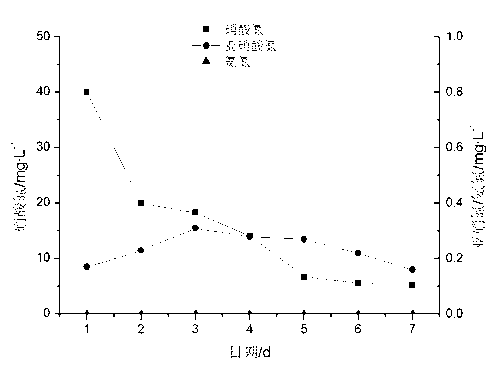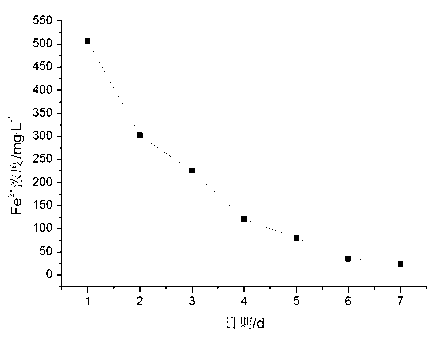Iron matrix autotrophic denitrification microbacterium strain and application thereof
A technology of denitrifying bacteria and denitrifying microbacteria, applied in the fields of bioengineering and environmental engineering, can solve problems such as increased operating costs, and achieve the effects of low cost, simple process, and strong practical value
- Summary
- Abstract
- Description
- Claims
- Application Information
AI Technical Summary
Problems solved by technology
Method used
Image
Examples
Embodiment 1
[0018] Example 1 Screening and Identification of Bacterial Strains
[0019] (1) Take 30mL of deep sediment from East Lake in Wuhan City, Hubei Province and add it to a closed Erlenmeyer flask containing 100mL of iron-based autotrophic denitrification liquid medium, and then place it on a constant temperature shaker at 30°C with a speed of 150r / min for shaking culture 4~5d, obtain the enriched bacterial liquid;
[0020] (2) Take 30mL of the enriched bacteria solution and add it to the Erlenmeyer flask containing 100mL of iron-based autotrophic denitrification medium, repeat the culture conditions of step (1) for 3 to 5 times, until the nitrate nitrogen in the bacterial suspension has a certain After the removal rate, the domesticated bacteria liquid is obtained;
[0021] (3) Gradual dilution of the domesticated bacteria solution, the dilution gradient is 10 -2 、10 -4 、10 -6 、10 -8 , respectively take 1mL of domesticated bacteria solution and add it to the plate of solid ...
Embodiment 2
[0029] The denitrification characteristics of iron-substrate autotrophic denitrifying Microbacterium W3 were studied through experiments. The method is to inoculate a closed shake flask with 5% inoculum, at pH 6.8~7.0, temperature 30°C, NO 3 - -N initial concentration is 40 mg / L, Fe 2+ The initial concentration of 500mg / L was cultivated for 7 days, during which the NH in the culture medium was continuously monitored. 4 + -N, NO 2 - -N, NO 3 - -N and Fe 2+ content, to study the autotrophic denitrification characteristics of strain W3 and its effect on Fe 2+ utilization. The result is as figure 2 , image 3 shown. from figure 2 , image 3 It can be seen that at pH6.8~7.0, at a temperature of 30°C, NO 3 - -N initial concentration is 40 mg / L, Fe 2+ Under the condition of the initial concentration of 500mg / L, the removal rate of nitrate nitrogen by iron-based autotrophic denitrifying microbacteria W3 can reach 87.0%. During the whole culture process, the producti...
Embodiment 3
[0031] The iron-substrate autotrophic denitrifying microbacterium W3 was expanded and then put into two identical continuous flow reactors loaded with sponge iron filler. Three weeks after the start-up of the film hanging, it was found that a layer of biofilm had been attached to the sponge iron filler in the two reactors, and it had a good removal effect on the nitrogenous sewage configured in the laboratory. It can be considered that both reactors are hanging The film was successful. Therefore, the influent water of the two biofilm reactors was replaced with pharmaceutical wastewater and battery factory wastewater, and their removal effect on nitrogen in wastewater was monitored after a week of stable operation. The experimental results are shown in Table 1.
[0032]
[0033] Table 1
[0034]
PUM
| Property | Measurement | Unit |
|---|---|---|
| Width | aaaaa | aaaaa |
| Length | aaaaa | aaaaa |
Abstract
Description
Claims
Application Information
 Login to View More
Login to View More - R&D
- Intellectual Property
- Life Sciences
- Materials
- Tech Scout
- Unparalleled Data Quality
- Higher Quality Content
- 60% Fewer Hallucinations
Browse by: Latest US Patents, China's latest patents, Technical Efficacy Thesaurus, Application Domain, Technology Topic, Popular Technical Reports.
© 2025 PatSnap. All rights reserved.Legal|Privacy policy|Modern Slavery Act Transparency Statement|Sitemap|About US| Contact US: help@patsnap.com



